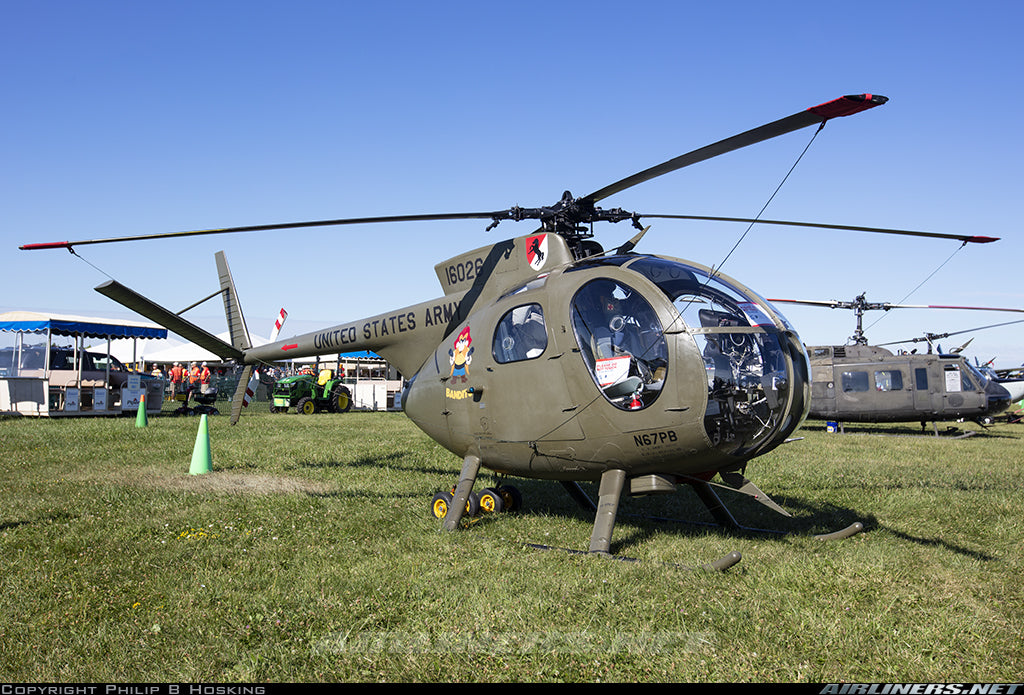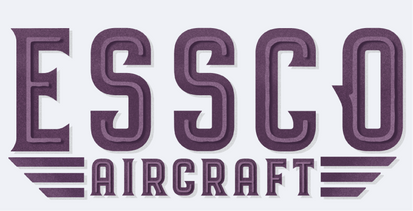
Number 38 of 100 in 100, the Hughes OH-6 🚁
Conceptualization:
The Hughes OH-6 was developed in the early 1960s as a response to the U.S. Army’s request for a Light Observation Helicopter (LOH). This need arose from the Army's desire for a nimble, lightweight helicopter capable of performing a variety of tasks such as personnel transport, reconnaissance, and light attack missions. During this period, military aviation was evolving, and the Army was seeking to replace older, less agile models with more versatile aircraft suited for the combat conditions of the Vietnam War. Hughes Helicopters submitted the Model 369, which later became the OH-6A Cayuse, in response to this request. With its teardrop-shaped fuselage, compact size, and cost-effective design, the OH-6 stood out from competing models. Its speed and maneuverability were critical for the low-altitude, fast-paced reconnaissance missions needed in Southeast Asia. In 1965, Hughes secured the contract due to the aircraft's lower production costs and excellent performance during testing.
Original Design:
The Hughes OH-6 Cayuse was distinguished by several unique design elements that catered specifically to its intended role in military reconnaissance and light attack missions. Its teardrop-shaped fuselage reduced drag and provided the helicopter with a high degree of speed and maneuverability. This compact shape, along with its bubble canopy, offered pilots 360-degree visibility, essential for spotting targets and navigating difficult terrain during low-level operations. The aircraft was powered by a four-blade main rotor and a two-blade tail rotor, which contributed to its agility in the air. The lightweight construction using semi-monocoque techniques allowed for quick and simple maintenance, making the helicopter reliable even under harsh combat conditions. The original design emphasized performance, ease of handling, and durability, all of which made the OH-6 a standout helicopter for the Army.

Photo Credit: airliners.net - Alex Christie
Principal Designer:
The design of the Hughes OH-6 was largely led by an engineering team at Hughes Helicopters. Although Howard Hughes was the figurehead of the company, much of the technical work was carried out his team of experienced engineers. Hughes Helicopters had already established itself in the aviation industry with the earlier success of the Hughes 269, which was widely used for training. The OH-6 took many of the lessons learned from the 269 and improved upon them, particularly in terms of speed and combat survivability. After the OH-6, Hughes Helicopters went on to design the Hughes 500 series, which became one of the most successful commercial helicopter models, and later contributed to the development of the AH-64 Apache after Hughes Helicopters was acquired by McDonnell Douglas.
Production Run:
Production of the Hughes OH-6 Cayuse began in 1965 after Hughes Helicopters won the Army's LOH competition. The Army initially ordered 714 helicopters, but this number was later increased to 1,300 units, with production peaking during the Vietnam War. The OH-6 proved itself invaluable in combat, particularly for its ability to perform low-altitude reconnaissance and transport missions in hostile environments. By the time production ended in the early 1970s, 1,420 OH-6A helicopters had been built. Although production for the U.S. military eventually shifted to the Bell OH-58 Kiowa due to cost concerns, the Hughes 500 series, a civilian variant of the OH-6, continued to be manufactured and remained popular in civilian and international military markets.

Photo Credit: airliners.net - Sergey Rimsha
Evolution:
Over the years, the OH-6 underwent numerous upgrades and modifications, resulting in several key variants. The YOH-6A was the initial prototype model. The OH-6A, powered by an Allison T63-A5A turboshaft engine, became the first production model. The OH-6B and OH-6C each received engine upgrades, the Allison T63-A720 and Allison 250-C20 respectively. The AH-6 and MH-6 variants were adapted for use by U.S. Special Operations Forces, with the AH-6 serving as a light attack helicopter and the MH-6 being used for troop insertion and extraction. The Hughes OH-6 evolved from a simple light observation helicopter into a versatile platform used across a variety of industries and military applications.
Specifications:
Hughes OH-6A Cayuse – Specifications Sheet
General Characteristics:
- Crew: 1 (pilot)
- Capacity: 3 passengers or 2 litters (medevac role)
- Length: 30 feet, 10 inches (9.4 meters)
- Height: 8 feet, 9.5 inches (2.68 meters)
- Main Rotor Diameter: 26 feet, 4 inches (8.03 meters)
- Rotor Area: 545.5 square feet (50.68 square meters)
- Fuselage Width: 3 feet, 10 inches (1.17 meters)
- Empty Weight: 1,160 lbs (526 kg)
- Max Takeoff Weight: 2,350 lbs (1,066 kg)
Performance:
- Maximum Speed: 152 mph (245 km/h, 132 knots)
- Cruising Speed: 135 mph (217 km/h, 117 knots)
- Range: 267 miles (430 km)
- Service Ceiling: 15,000 feet (4,570 meters)
- Rate of Climb: 2,000 feet per minute (10.2 m/s)
- Hover Ceiling (Out of Ground Effect): 11,000 feet (3,350 meters)
Powerplant:
- Engine: 1 × Allison T63-A-5A turboshaft
- Power Output: 317 shp (237 kW)
Fuel Capacity:
- Fuel Capacity: 62 US gallons (235 liters)
Rotor System:
- Main Rotor: 4-blade system
- Tail Rotor: 2-blade system
Armament (Optional for Military Variants):
- Machine Guns:
- 2 × 7.62 mm M60 machine guns, door-mounted or externally mounted
- 1 × 7.62 mm minigun (optional)
- Rocket Pods:
- 2 × 7-shot 2.75 in (70 mm) rocket pods
- Grenade Launchers:
- M75 40mm grenade launcher (optional for armed reconnaissance role)
Avionics:
- Basic avionics suite including:
- Communications equipment
- Navigation systems
- Military variants often had enhanced surveillance and observation equipment tailored for reconnaissance missions.
In Comparison to Other Aircraft in its Category:
The Hughes OH-6A outperformed many of its contemporaries in speed, with a maximum of 152 mph, surpassing the Bell OH-58 Kiowa's 120 mph and comparable to the Eurocopter AS350's 155 mph, though the AS350 was more suited for civilian roles. The OH-6A had a range of 267 miles, slightly less than the OH-58’s 299 miles and significantly shorter than the AS350’s 403 miles, making the latter more suitable for long-range missions. While the OH-6A could carry up to 3 passengers and light armaments, the AS350 had a higher payload capacity for civilian tasks, and the OH-58 was more flexible in later roles with advanced weaponry. In terms of service ceiling and climb rate, the OH-6A excelled at 15,000 feet and 2,000 feet per minute, outpacing the OH-58, but the AS350 offered better performance in high-altitude environments. Overall, the OH-6A was a versatile military helicopter, with the Kiowa and AS350 offering different strengths in endurance, civilian use, and advanced armament capabilities.

Photo Credit: airliners.net - Fred Willemsen
Performance:
Hughes OH-6A Cayuse – Performance Envelope
V-Speeds (Velocity Speeds):
- V_NE (Never Exceed Speed): 150 knots (173 mph, 278 km/h)
- V_NO (Maximum Structural Cruising Speed): 120 knots (138 mph, 222 km/h)
- V_H (Maximum Level Flight Speed): 132 knots (152 mph, 244 km/h)
- V_R (Maximum Rate of Climb Speed): 53 knots (61 mph, 98 km/h)
- Best Glide Speed (Auto-Rotation): 58 knots (67 mph, 107 km/h)
Operating Limits:
- Rotor RPM (N_R) Limits:
- Maximum Rotor RPM (Power-On): 485 RPM
- Minimum Rotor RPM (Power-On): 471 RPM
- Rotor RPM (Power-Off): 425-485 RPM
- Powerplant Temperature Limits:
- Max Continuous Torque: 100% (Torque meter)
- Maximum Transient Torque: 110% for 5 seconds
Maneuvers Approved:
- Normal Flight: Approved for all normal flight operations, including:
- Low-altitude operations: The OH-6 was designed for close-ground reconnaissance and low-level flying, which is well-suited to missions that require flying close to obstacles and maintaining situational awareness.
- Hovering: Both in- and out-of-ground-effect hovering is permitted. The OH-6's rotor system provides excellent performance, even in hover with the full gross weight.
- Steep Approaches: Approved for steep approaches, allowing pilots to perform quick, tight landings and takeoffs in confined areas.
- Autorotation: Fully capable of autorotation in the event of engine failure. The OH-6 is known for its forgiving autorotation characteristics, giving pilots good control during emergency descent.
- Quick-Stop Maneuvers: These maneuvers are part of standard operations for light helicopters like the OH-6, allowing pilots to quickly reduce forward speed and enter a hover. This is useful for surveillance, reconnaissance, and light transport operations.
Maneuvers Not Approved:
- Aerobatic Maneuvers: Aerobatic flight, such as rolls, loops, or inverted flight, is not approved due to the design of the rotor system and airframe.
- Negative-G Maneuvers: Sustained negative-G flight is prohibited, as the helicopter's rotor system is not designed for operation in this flight regime.
The performance of the OH-6 was ideally suited for its roles in training and reconnaissance. Its low rotor inertia meant that the helicopter was highly maneuverable, allowing pilots to perform quick, evasive maneuvers at low altitudes. However, this also required pilots to be vigilant during autorotation, as managing rotor RPM was critical to safe landings in engine-out scenarios. Despite this challenge, the OH-6’s responsive controls, fast climb rate, and ability to hover made it a valuable tool for both training new pilots and conducting precise reconnaissance missions. Its steep approach and quick-stop maneuvers were essential for operating in combat zones where fast, agile flight was required.
Safety Record:
The OH-6 has a notable safety record, particularly in combat situations where its robust construction allowed it to survive significant damage. However, the helicopter’s low rotor inertia was a concern, as it left less room for error during autorotation. This made proper training essential for pilots. Despite the inherent risks of combat flying, the OH-6 proved highly survivable, with many pilots crediting its ability to take damage and keep flying. In civilian use, its safety record remained strong, with most accidents linked to operational risks rather than mechanical failure.
Acquisition Cost:
The original acquisition cost of the Hughes OH-6A was approximately $19,860 per airframe (excluding the engine), making it one of the more affordable helicopters during its production era. This low cost was a key factor in its selection by the U.S. Army. Today, restored OH-6A helicopters or their civilian counterparts, the Hughes 500 series, can range from $500,000 to $900,000, depending on condition and modifications.
Conclusion:
The Hughes OH-6 Cayuse is renowned for its versatility and durability, excelling in military and civilian roles. Originally built for the U.S. Army's light observation needs, its agility and resilience made it indispensable during the Vietnam War. Over time, the OH-6 evolved into the Hughes 500 and MD 500 series, continuing to serve in law enforcement, military, and civilian aviation worldwide, showcasing innovative design and enduring operational flexibility.

Photo Credit: airliners.net - Jerome Mervelet
Bibliography:
Essco Links:
